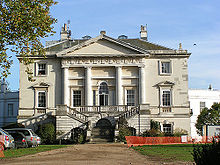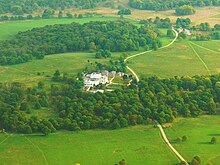White Lodge
The White Lodge is a mansion in the London Borough of Richmond upon Thames . On the site of Richmond Park , the building was built in 1727 under the direction of the architect Roger Morris in collaboration with Henry Herbert, 9th Earl of Pembroke . The Georgian style building with elements of Palladianism was originally built as a hunting lodge for King George II and then had various, mostly noble residents. Since 1955 it has served as a teaching facility for the next generation of ballet and is now used by the Royal Ballet School .
history
The client and his architects
Richmond Park has been known as the hunting ground of the English kings since the 13th century. George II selected two men for the new building of his hunting lodge who had previously worked together at the nearby Marble Hill House (1724-29). One of them, Henry Herbert, was part of a group of Architect Earls who, as architectural dilettantes , promoted Andrea Palladio's ideas in England. Together with the architect Roger Morris, he worked on several projects, the main work of which was the Palladian Bridge , built in 1736/7 , a portico-decorated bridge over the Nadder River in Wilton House Park .
The building of today's White Lodge is a cube with a portico in front , consisting of four columns and an unadorned gable. The basement is reached via a symmetrically arranged two-flight staircase. After the name Stone Lodge was initially used for the hunting lodge, the name New Lodge later prevailed , in contrast to the Old Lodge (demolished 1839–1841), also located in Richmond Park . In addition to George II, his wife Queen Caroline in particular used the building repeatedly on her outings. Their daughter Amelia received the office of Ranger of Richmond Park in 1751 , who had previously held Robert Walpole, 2nd Earl of Orford , the son of Prime Minister Robert Walpole .
Headquarters of the Ranger of Richmond Park
Princess Amelia held this office for the next ten years, during which time she lived in the New Lodge . She considered Richmond Park her private property and tried to close the gates of the walled area to the public. Here she encountered resistance from the local brewer John Lewis, who reached a court in April 1758 that pedestrians would continue to be allowed to cross the park. In the reign of Princess Amelia the extension of the building with two side wings, which was carried out by Stephen Wright , also fell.
Successor in the office of Ranger of Richmond Park was John Stuart, 3rd Earl of Bute , who lived in the New Lodge from 1761 to 1792 . The first documented mention of the building as White Lodge (after the white limestone facade of the house) dates from this time. Lady Mary Coke noted in her diary the visit to Richmond Park on July 24, 1768 and the name White Lodge for the former hunting lodge of George II.
Royal residents in the 19th century
George III 1801 left the country house to the Prime Minister Henry Addington, 1st Viscount Sidmouth , who from 1805 had a private garden laid out. Here he was later supported by the landscape architect Humphry Repton . Since the office of Ranger of Richmond Park was granted to George III. was exercised himself, he appointed Addington as his deputy in this function. After Addington died at White Lodge in 1844, Princess Mary, Duchess of Gloucester, moved into the house. She lived here again until her death in 1857. In the following year, the Prince of Wales and later King Edward VII. Lived in the White Lodge on the instructions of his father, in order to calmly prepare for exams in the military. The next royal residents were Duke Franz von Teck and his wife Mary Adelaide of Cambridge , a granddaughter of King George III. The couple lived here for almost 30 years and their daughter Maria von Teck (later Queen Mary) spent most of her childhood at White Lodge. After her marriage to Prince George, Duke of York (later George V), she gave birth to the future King Edward VIII on June 23, 1894 in the White Lodge .
The White Lodge in the 20th century
After the death of the Duchess (1897) and Duke von Teck (1900), a Mrs. Hartman lived on the property until 1909. Queen Mary left White Lodge to her son, later George VI, in 1923 . , and his wife Elizabeth Bowes-Lyon shortly after their marriage. However, the parents of today's Queen Elizabeth II only stayed here for a few years, as they saw their privacy disturbed by the numerous curious visitors.
In 1927 Arthur Lee, 1st Viscount Lee of Fareham, moved into the White Lodge, which was later replaced by Colonel James Veitch as the last private resident for the time being. After he moved out in 1954, the residential building was rededicated as a training facility for the next generation of ballets. From 1955 the ballet school of Sadler's Wells Theater used the building, which has been teaching 11 to 16-year-old students since 1956 as the Royal Ballet School in the White Lodge.
literature
- John Cloake: Palaces and parks of Richmond and Kew . Phillimore, Chichester 1996, ISBN 978-1860770234 .
Individual evidence
- ↑ This group included, for example, Edward Stratford, 2nd Earl of Aldborough and Richard Boyle, 3rd Earl of Burlington .
Web links
Coordinates: 51 ° 26 ′ 43 " N , 0 ° 15 ′ 54" W.

